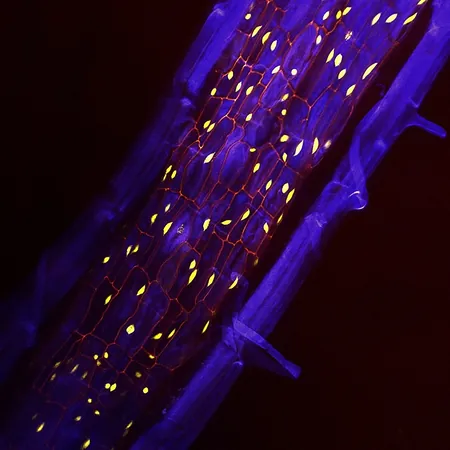
Groundbreaking Study Unveils How Plants Can Armor Up Against Climate Change with New Gene Insights
2025-01-09
Author: Arjun
Introduction
In a world where plants are anchored to their spots, they face daunting environmental threats, from extreme temperatures to droughts and microbial infestations. To combat these challenges, plants have evolved protective mechanisms that allow them to adapt and endure. A remarkable breakthrough from researchers at the Salk Institute reveals how these adaptations work at a genetic level, particularly focusing on the development of a unique protective structure called the periderm.
The Role of Periderm in Plant Health
The periderm acts as a vital armor, safeguarding the roots and helping plants manage climate-induced stresses. Traditionally, plant biologists have concentrated on young plants; however, this new study breaks new ground by providing the first comprehensive gene expression atlas of the periderm at the single-cell level. Released in the scientific journal Developmental Cell, the findings were shared on January 9, 2025, highlighting important discoveries about cell types and genetic regulations governing the periderm's development.
Significance of Phellem Cells
Crucial to this study was the exploration of phellem cells, which are packed with a special molecule known as suberin. This compound plays two significant roles: it helps sequester carbon from the atmosphere and guards the plant's roots against environmental stressors. With climate change presenting formidable challenges to plant survival, understanding how to enhance this process could revolutionize carbon capture strategies.
Expert Insights
According to Professor Wolfgang Busch, the senior author and director of Salk's Harnessing Plants Initiative, "Plants play a crucial role in capturing and storing carbon in the soil. By mapping the formation and maturation of these essential root cells, we can stimulate growth to help plants retain more carbon in robust, enduring forms." The study aims to engineer stronger plants equipped to trap carbon and withstand climate challenges more effectively.
Evolution of Root Growth
When a plant initially takes root, its primary growth phase focuses on lengthening roots. As it matures, the focus shifts to secondary growth, building up thick, durable roots veiled in periderm. This protective layer, comprised of phellem, phellogen, and phelloderm cells, has previously stumped researchers, as the nuances of their development remained largely unexplored.
Innovative Research Techniques
Using state-of-the-art single-cell sequencing technology, the Salk team captured the unique genetic blueprints of each periderm cell type, allowing for unrivaled detail in their study. First author Charlotte Miller remarks, "Previous studies often overlooked the distinct cell types by analyzing roots in bulk. Our innovative approach lets us delve deeper into individual cell lineages, making our research more precise and efficient."
Genetic Regulatory Pathways
The research unveiled that phellem cells evolve through a series of genetically distinct phases regulated by key genes—including MYB67, a vital player in the development process. As the researchers examine these genetic pathways, they anticipate discovering ways to cultivate plants with enhanced phellem cell production, leading to stronger carbon storage capabilities.
Broader Implications
Moreover, this atlas provides insights into other cell types in the periderm, allowing scientists to better understand how cells transition during periderm development. The extraordinary ability of phellogen cells to transform into various cell types later in a plant's life cycle surprises researchers, highlighting the complexity and adaptability of plant growth.
Potential for Future Innovations
Busch is particularly intrigued by how suberin-rich cells may help seal the damage caused by new lateral root growth, a process that often compromises plant integrity. Understanding these dynamics could pave the way for optimizing root systems that can expand while effectively fending off infections.
Conclusion
The implications of this research are monumental, offering a fertile ground for inventions aimed at creating climate-resilient crops. With this newfound knowledge, the challenges posed by climate change may find a formidable ally in our botanical companions, reaffirming their role as crucial allies in our quest to restore the balance of our ecosystems.
 Brasil (PT)
Brasil (PT)
 Canada (EN)
Canada (EN)
 Chile (ES)
Chile (ES)
 Česko (CS)
Česko (CS)
 대한민국 (KO)
대한민국 (KO)
 España (ES)
España (ES)
 France (FR)
France (FR)
 Hong Kong (EN)
Hong Kong (EN)
 Italia (IT)
Italia (IT)
 日本 (JA)
日本 (JA)
 Magyarország (HU)
Magyarország (HU)
 Norge (NO)
Norge (NO)
 Polska (PL)
Polska (PL)
 Schweiz (DE)
Schweiz (DE)
 Singapore (EN)
Singapore (EN)
 Sverige (SV)
Sverige (SV)
 Suomi (FI)
Suomi (FI)
 Türkiye (TR)
Türkiye (TR)
 الإمارات العربية المتحدة (AR)
الإمارات العربية المتحدة (AR)